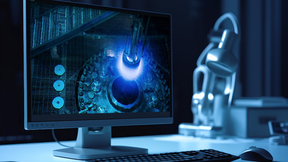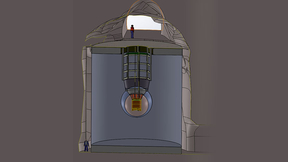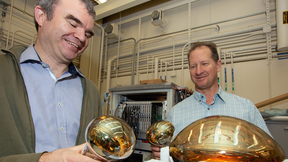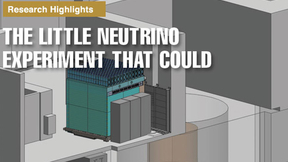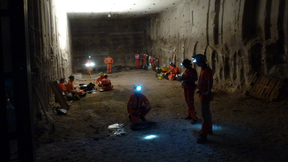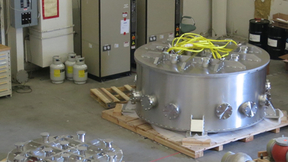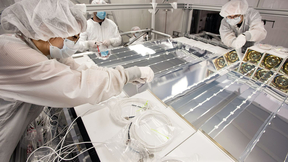Back
Neutrinos
Search for sterile neutrinos continues at nuclear reactors
Neutrinos, elusive fundamental particles, can act as a window into the center of a nuclear reactor, the interior of the earth, or some of the most dynamic objects in the universe. Their tendency to change "flavors" may provide clues into the prominence of matter over antimatter in the universe or explain the existence of dark matter. Physicists are particularly interested…
'Lighting' up antineutrino detection
How do you find and measure nuclear particles, like antineutrinos, that travel near the speed of light? Antineutrinos are the antimatter partner of a neutrino, one of nature’s most elusive and least understood subatomic particles. They are commonly observed near nuclear reactors, which emit copious amounts of antineutrinos, but they also are found abundantly throughout the…
Three selected as Graduate Student Research program recipients
Three graduate students have earned Department of Energy (DOE) Office of Science Graduate Student Research (SCGSR) Program awards to perform their doctoral dissertation research at Lawrence Livermore National Laboratory (LLNL). The prestigious award helps cover living expenses and travel for 60 students from universities across the nation. Their proposed research projects…
Lab scientist wins Springer Thesis Award for work in neutrino research
Lawrence Livermore National Laboratory (LLNL) postdoc Sam Hedges has won a 2024 Springer Thesis Award for his work in searching for the elusive neutrino. “I’m honored that my thesis was nominated for this award, and was excited when I found out it had won,” Hedges said. His thesis, “Low Energy Neutrino-Nucleus Interactions at the Spallation Neutron Source," highlights the…
PROSPECTing new perspective on reactor-produced neutrinos
While neutrinos are one of the most common particles in the universe, their elusive nature makes it challenging to understand their behavior. In new research from the Precision Reactor Oscillation and Spectrum (PROSPECT) Experiment, scientists have produced final results from measurements of neutrinos emitted by a nuclear reactor at the Oak Ridge National Laboratory. Their…
Lab-led nEXO project receives Inflation Reduction Act funding
Lawrence Livermore National Laboratory (LLNL) has received $2.35 million from the Inflation Reduction Act, which aims to support domestic energy production and promote clean energy and to provide the Department of Energy (DOE) national laboratories with resources to keep the U.S. at the forefront of scientific discovery. The funding has been allocated for the Lab-led nEXO…
Laboratory researchers describe how antineutrino detectors could aid in nuclear nonproliferation efforts
A tiny, invisible particle could offer help for a big problem — the threat of nuclear proliferation. For more than six decades, scientists have been developing instruments for fundamental physics that can detect antineutrinos, particles that have no electric charge, almost no mass and easily pass through matter. Antineutrinos are emitted in vast quantities by nuclear…
The Little Neutrino Experiment That Could
Many experiments conducted by Lawrence Livermore researchers are designed to explore questions of fundamental science. Others are intended to test-drive new mission-critical technologies. Perhaps the most exciting experiments are those that undertake both objectives. PROSPECT, the Precision Oscillation and Spectrum Experiment, is a unique neutrino–antineutrino detection…
A universal tool to improve global security
Elusive antineutrinos can help monitor nuclear power plants and other activity The United Kingdom is investing nearly £10 million (about $12.7 million) in a joint project with the United States to harness existing particle physics research techniques to remotely monitor nuclear reactors. Expected to be operational in 2024, the Advanced Instrumentation Testbed (AIT) project…
Victory Through Annihilation: Jason Brodsky’s Neutrinos that Saved the Universe
Jason Brodsky says his work is like “looking for a candle in a raging inferno.” But the Lawrence Livermore physicist believes finding that “candle” could be the key to understanding existence itself. Brodsky’s specialty is rare-event detection, both during his Princeton graduate work on dark matter and his current postdoctoral research at LLNL, in which he searches for…
Understanding the universe through neutrinos
Determining features of the elusive particle known as a neutrino – through the observation of an extremely rare nuclear process called neutrinoless double-beta decay (NDBD) -- could provide a glimpse into the nature of the universe during the earliest moments of the Big Bang. As part of an international collaboration, Lawrence Livermore National Laboratory (LLNL)…
PROSPECTing for antineutrinos
The Precision Reactor Oscillation and Spectrum Experiment (PROSPECT) has completed installation of a novel antineutrino detector that will probe the possible existence of a new form of matter -- sterile neutrinos. PROSPECT, located at the High Flux Isotope Reactor (HFIR) at the Department of Energy’s Oak Ridge National Laboratory (ORNL), has begun taking data to study…
Lawrence Livermore to lead United States-United Kingdom consortium for demonstrating remote monitoring of nuclear reactors
LIVERMORE—Harnessing the unusual characteristics of the elusive subatomic particles known as antineutrinos, Lawrence Livermore National Laboratory (LLNL) will lead a new international multi-laboratory and university collaboration for nonproliferation research. The program will support the development of detection hardware and algorithms to enable improved nonproliferation…






